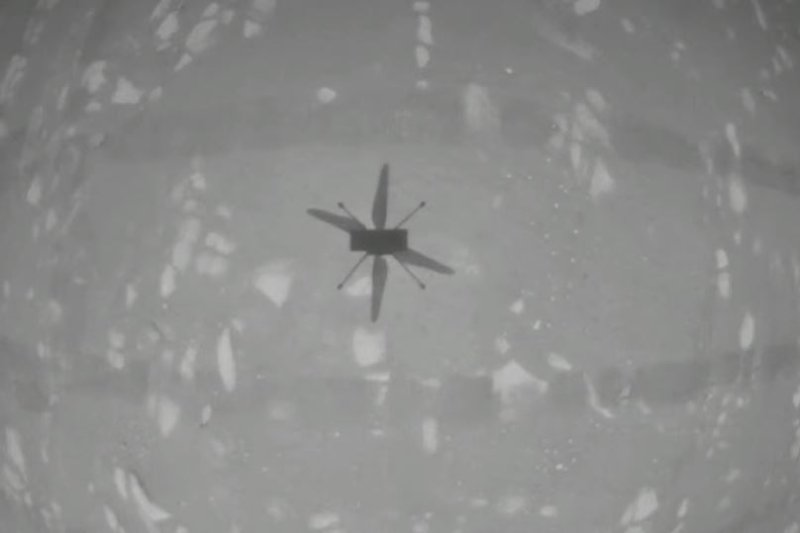1 of 6 | A photo from a camera on the Mars helicopter Ingenuity shows the shadow of the aircraft during its first flight on the planet Monday. Photo courtesy of NASA
ORLANDO, Fla., April 19 (UPI) -- NASA confirmed Monday the historic first flight of a powered aircraft on another planet, the Mars helicopter Ingenuity.
Engineers cheered and applauded during a live broadcast as data confirming the flight arrived from the distant planet to the space agency's Jet Propulsion Laboratory in Pasadena, Calif.
The helicopter performed "spinup, takeoff, climb, hover, descent, landing and spin down," said Håvard Grip, who carries the title of chief pilot for the remote mission. The time of flight was about 3:30 a.m. EDT.
The flight prompted NASA to establish a pilot's logbook for flights on other planets, Grip said, showing the red, hard-cover journal at a press conference Monday afternoon.
The International Civil Aviation Organization gave the helicopter an official designation, IGY. The Jezero Crater location is JZRO, while the helicopter's flight location is now named Wright Brothers Field.
"We can now say that we have performed a successful flight on another planet," said MiMi Aung, project manager for the helicopter.
Images from the aircraft showed the helicopter's shadow on the surface during flight, while additional footage from the Perseverance rover's camera showed the aircraft hovering.
The 4-pound, solar-powered helicopter flew for 39 seconds to 10 feet above the surface to demonstrate flight capability in the thin Martian air.
The success means aircraft are likely to become a permanent part of planetary exploration, said Michael Watkins, the JPL director, after further downloads of data Monday afternoon.
"What the Ingenuity team has done is ... freed us from the surface now, forever in planetary exploration," Watkins said, adding that rover and aircraft can work together on future missions.
The helicopter blew dust off its solar panels during the flight, and landed without kicking up more, so it is functioning with more solar power now than after the flight, officials said.
The Perseverance rover and helicopter landed on Mars on Feb. 18, and the rover released the helicopter from its underside on April 4. NASA has planned only 30 days of experimental flight with Ingenuity, an $80 million technology demonstration.
NASA intends to try another flight to push the height and function of the helicopter, possibly by Thursday.
Eventually, engineers want to fly to about 1,600 feet, testing the Martian winds and temperature differences -- although the exact flight plans haven't been determined, controllers said.
Since the goal for the mission is to gather data and learn how future aircraft should be designed, Ingenuity may crash on its final mission, Aung said Monday afternoon.
"We want ... to make sure that in fact, we're putting the pedal down," she said. "We want to push, to push against the wind, we want to push against the speed and ultimately we expect the helicopter will meet his limit."
Ingenuity is completely dependent on Perseverance for communications with Earth. NASA plans to abandon the helicopter to allow the rover to continue its primary mission -- drilling rock samples that could contain signs of past life on Mars.
Ingenuity's dual rotors are 4 feet long and made of lightweight carbon fiber composite. To cope with the thin air on Mars, they rotate at 2,500 revolutions per minute, which compares to helicopters on Earth that function at 400 to 500 revolutions per minute.
NASA's Perseverance Mars rover, using its Mastcam-Z camera system, captured this view of the Martian sunset on November 9, 2021, the 257th Martian day, or sol, of the mission. Martian sunsets typically stand out for their distinctive blue color as fine dust in the atmosphere permits blue light to penetrate the atmosphere more efficiently than colors with longer wavelengths. But this sunset looks different: Less dust in the atmosphere resulted in a more muted color than average. The color has been calibrated and white-balanced to remove camera artifacts. Photo courtesy of NASA |
License Photo
















